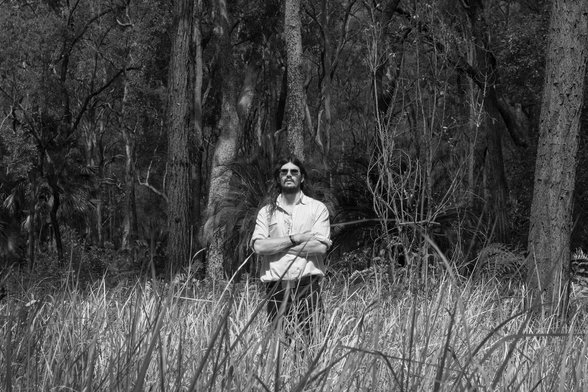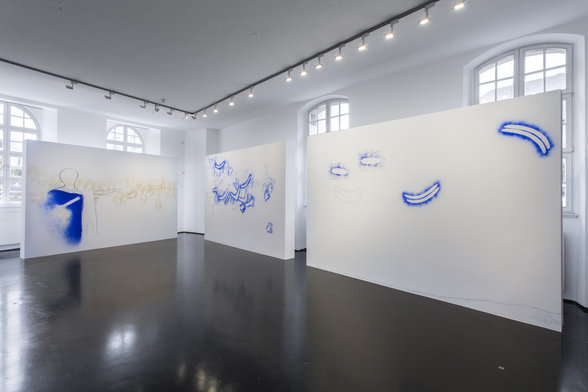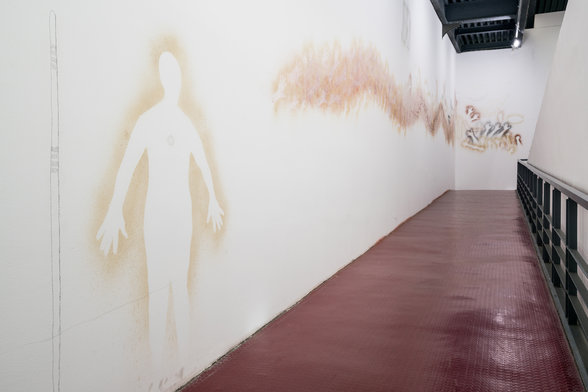'What I do is grounded in my family's cultural inheritance' – Dale Harding
Posted on 1 May 2018 by Liverpool Biennial
Dale Harding, Ngaya boonda yinda nayi yoolgoogoo - I carry you in my heart, 2016
Artist Dale Harding is a descendant of the Bidjara, Ghungalu and Garingbal peoples of Central Queensland and lives in Brisbane, Australia. After initially working at a paint company, he embarked on a career as a full-time artist having been accepted onto the Contemporary Australian Indigenous Art course (CAIA) at Griffith University’s Queensland College of Art. For Liverpool Biennial 2018, Harding will explore his cultural heritage through a brand new wall painting at Tate Liverpool. He will use the pigment Reckitt’s Blue, a colour used in a laundry detergent closely linked with the frontier of the British Empire, to connect histories from different parts of the globe.
What I do is grounded in my family's cultural inheritance. As a family and a cultural unit, we identify with both our home and the landscape, even when we make interventions or present work in a different space. That’s the driving force behind why, over the last few years, I’ve chosen to put my wall paintings onto the architecture of contemporary art galleries. In my mind, there’s no separation between the environments of my ancestors and these built, architectural spaces.

Dale Harding, 2016. Photo: Karen Lawton
Every time a wall painting gets made by me and my family in a contemporary gallery, it’s always a register of the makers. When I’ve made a wall painting recently, it’s a lot higher than other motifs that were done by my family members because I’m tall. The wall paintings in many ways are a register of my body, and a register of my reach, my breath and my technique.
'The wall paintings in many ways are a register of my body'
The wall paintings that I’m making now and the ochres and pigments that I work with – such as Reckitt’s Blue – are all routed in the territories and the Great Dividing Range that runs through the region where I am from. I am a Bidyara man, which I take from my grandfather. That’s on the higher sandstone plateaus of Western Queensland. Over into the more arid areas, down into the sandstone sections, are the Garingbal country and Carnarvon gorge. And then over into the Blackdown Tablelands and into Ghungalu country, which is where where my grandmother is from.

Dale Harding, Composite wall panel: Reckitts blue, 2017. Installation view at Naturkundemuseum im Ottoneum, Kassel, documenta 14. Image courtesy the artist and Milani Gallery, Brisbane. Photo: Roman März
I didn’t grow up under government control, and neither did my mother, but her mother and all of her extended network of family did. It is often said that there isn’t an aboriginal family in Queensland which hasn’t been affected by the missions.
It was the practice of the Department of Native Affairs to require aboriginal people to apply for, and be granted, the right to be able to move beyond the confines of the mission system. There was government legislation that required all aboriginal people in the state of Queensland to liaise with police and the mission about their movements and daily lives. My grandmother had to be given her exemption from that legislation before she could go on and live her life as a young woman.

Dale Harding, Untitled: wall painting, 2016. Installation view at 11th Gwangju Biennale, Gwangju, Republic of Korea. Image courtesy the artist and Milani Gallery, Brisbane. Photo: Gwangju Biennale
Throughout 2015 and into 2016, I was involved in a group show in Western Sydney at the Campbelltown Arts Centre. It was a memorial for the 200th anniversary of the Appin Massacre, which was sanctioned and ordered by Lachlan Macquerie, the Governor of New South Wales at the time. There were a number of Australian aboriginal artists and First Nation artists involved in the project, including others from North America and Canada.
In that process, connecting with and sharing dialogue with those other artists, the similarities of experience and the colonial processes, formats, and formulas of how these things occurred, became really clear to me. A number of us had familiar and shared experiences, even though we'd been in different times and different places.
I had a professor at Queensland College of Art, Jennifer Herd, who is an aboriginal woman from the Mbar-barrum people and a founding senior member of the ProppaNOW artist collective in Brisbane. She would say that I am to always be aware of what I am working towards. Referring to her work around warrior women, Jennifer would say that as a warrior, you need to know what you’re fighting for. To push forth something, you need to know what it is and what the outcome is.
See Dale Harding's work at Tate Liverpool as part of Liverpool Biennial 2018: Beautiful world, where are you? from 14 July – 28 October.
Liverpool Biennial
55 New Bird Street
Liverpool L1 0BW
- T +44 (0)151 709 7444
- info@biennial.com
Liverpool Biennial is funded by
Founding Supporter
James Moores
